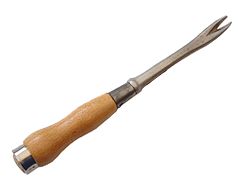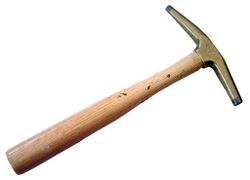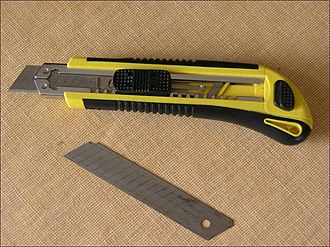Difference between revisions of "AY Honors/Upholstery/Answer Key"
| Line 27: | Line 27: | ||
===e. Sharp Knife or “Snap” blade knife === | ===e. Sharp Knife or “Snap” blade knife === | ||
| + | [[Image:Utility knife.jpg|thumb|300px|Snap blade knife]] | ||
| + | A snap blade knife is a general-purpose utility knife used for cutting upholstery. When the tip becomes dull, the end of the blade can be snapped off, revealing a sharp, new tip. When the last tip is used, the knife can be refilled with a new blade. | ||
| + | |||
| + | Be careful to properly dispose of the snapped-off tips. They are still sharp enough to pose a danger to anyone who picks it up (either intentionally or not). | ||
| + | |||
| + | {{clear}} | ||
| + | |||
===f. Work Table === | ===f. Work Table === | ||
===g. Industrial Sewing Machine === | ===g. Industrial Sewing Machine === | ||
Revision as of 01:16, 28 November 2008
1. Know five of the following terms used in upholstery to describe the tools and give their uses:
a. Tack Claw
A tack claw is a tool used for pulling tacks out of furniture. One end has a handle by which the tool is gripped. The other end has a claw which is wedged underneath the head of the tack. The handle is then either lifted or pushed down, levering out the tack.
b. Staple Remover
A staple knocker is a tool resembling a screwdriver, used for removing staples and shredded material. It is called a knocker because a hammer can be used to hit the end of it and remove long lines of shorter staples.
c. Regulator, Mattress Needle
An upholstery regulator is an upholstery tool which smooths irregularities in the stuffing beneath the coverings.
Whilst it looks similar to a needle it is heavier; like needles the regulator comes in various gauges and lengths. It is used to poke through the various layers to adjust the stuffing before the final cover is put in place.
A related tool is the stuffing iron, which is used to push the stuffing into the curves and corners of a piece of furniture; it has a narrow piece of steel with one toothed edge to grab loose stuffing and place it in the hard to reach spots.
d. Magnetic Hammer
A magnetic hammer (also called a tack hammer or an upholstery hammer) is a lightweight hammer used for securing upholstery fabric to furniture frames using tacks.
One face of the hammer is magnetized to aid in placement of tacks. Once started, the tacks are driven with the other face. Staple guns have largely replaced tacking as an upholstery technique, except where decorative tacks are used. In the case of decorative tacks, the non-magnetic face of the hammer is often outfitted with a nylon tip so that the tack is not marred as it is driven in place.
e. Sharp Knife or “Snap” blade knife
A snap blade knife is a general-purpose utility knife used for cutting upholstery. When the tip becomes dull, the end of the blade can be snapped off, revealing a sharp, new tip. When the last tip is used, the knife can be refilled with a new blade.
Be careful to properly dispose of the snapped-off tips. They are still sharp enough to pose a danger to anyone who picks it up (either intentionally or not).
f. Work Table
g. Industrial Sewing Machine
h. Sundry Items
Sundry items include:
- Tacks
- Tacks are used for holding upholstery fabric to the wooden frame of an item of furniture. They can be hidden, or they can be decorative.
- Staples
- Staples are much easier to use than tacks, and have largely replaced tacks where they are hidden (such as the underside of a chair or couch).
- Webbing
- Webbing is frequently used to form a base that supports a cushion. It is put in place with the aid of a web stretcher.
- Twine
- Rather than using thread, upholsterers use twine of various sizes. Number 5 twine is used to lash springs into place. Numbers 3 and 1 are smaller and are used for stitching fabric.
2. Explain the use of the following items:
a. Webbing
Webbing is used in couches and chairs as a base for the seating areas that is both strong and flexible. Many types of outdoor furniture use little more than thin light webbing for the seating areas. Webbing is also used to reinforce joints and areas that tend to flex.
b. Staples and Tacks
Staples and tacks are used for holding fabric in place. Staples are used only where they will be hidden. Tacks are used when the seam will be seen.
c. Hessian
Hessian (also called burlap) is a coarse cloth made of vegetable fibers. In upholstery it is used as an internal layer to hold batting in place. It is also used on the underside of furniture. Hessian is a very strong cloth and is used as a support cloth and as a liner.
d. Buttoning Cord or Waxed Flax
These items are used where very strong twine is needed, such as for holding buttons in place. The wax on the twine helps the twine stay in place as it is tightened.
e. Calico
Calico is a textile made from unbleached, and often not fully processed, cotton. It may contain unseparated husk parts, for example. The fabric is less coarse and thick than canvas or denim, but owing to its unfinished and undyed appearance, it is still very cheap.
f. Fibre
g. Flock
Flocking is a type of texture applied to a surface.
"Flocking" is a decoration process that enhances the way a wide variety of products are experienced by making ordinary surfaces seem far more magical and special. "Flocking" is the process of depositing millions of little individual cut fiber particles (called "flock") onto the surface of an article for the purpose of increasing its value in terms of the tactile sensation, aesthetics, color and appearance, and/or a wide variety of other functions--such as insulation, slip-or-grip friction, etc.
h. Foam Sheeting
i. Glues
j. Back Tacking Strip.
3. Name two types of material used for upholstery.
4. Explain how to fit the top cover to a lid.
5. What is the name of the material used for the base of lounges and the base of your box etc., and what is its purpose?
6. Name two methods of attaching covers to chairs.
7. Complete a or b:
a. Ottoman
b. Toybox
8. Complete a Feature Panel.
References
- Upholstery: A Complete Course : Chairs, Sofas, Ottomans, Screens and Stools By David James, published by Sterling Publishing Company, Inc., 1999; ISBN 1861081189, 9781861081186




